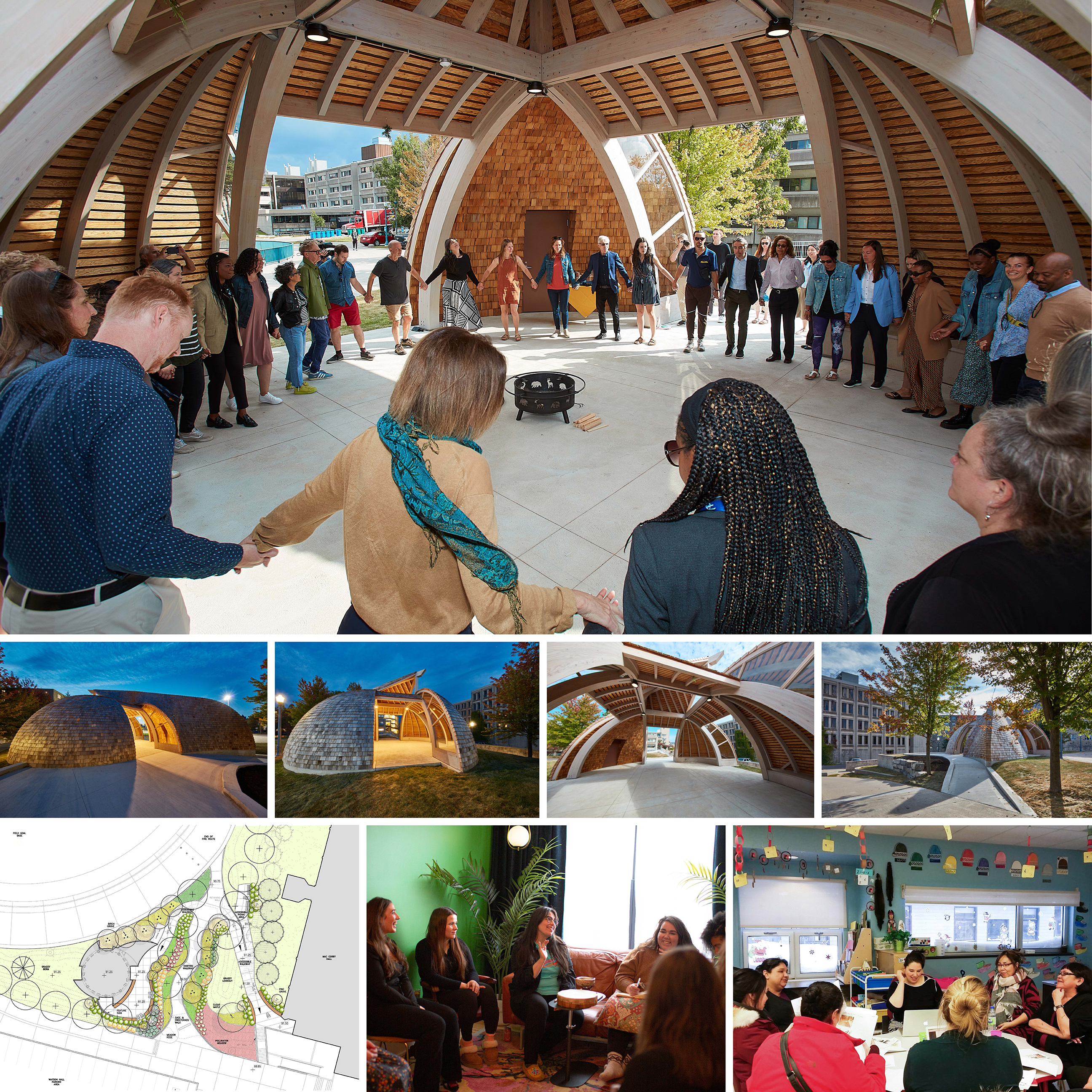
ELADIA SMOKE
OAA, MAA, LEED AP, FRAIC
Principal, Smoke Architecture
KaaSheGaaBaaWeak | Eladia Smoke is Anishinaabekwe from Obishikokaang | Lac Seul First Nation, with family roots in Alderville First Nation, Winnipeg, and Toronto. Eladia has worked in architecture since 2002, and founded Smoke Architecture as principal architect in 2014. She is the first Anishinabekwe architect in Manitoba, Ontario, and Quebec, and the third Indigenous woman licensed as an architect in Canada. Eladia taught at Laurentian’s McEwen School of Architecture 2016-2022, is a founding member of RAIC’s Indigenous Task Force, and a current member of The International Union of Architects Indigenous Peoples Work Programme. Eladia leads community-based and institutional projects to successful completion, working alongside Indigenous organizations and First Nation communities.
OAA, MAA, LEED AP, FRAIC
Principal, Smoke Architecture
KaaSheGaaBaaWeak | Eladia Smoke is Anishinaabekwe from Obishikokaang | Lac Seul First Nation, with family roots in Alderville First Nation, Winnipeg, and Toronto. Eladia has worked in architecture since 2002, and founded Smoke Architecture as principal architect in 2014. She is the first Anishinabekwe architect in Manitoba, Ontario, and Quebec, and the third Indigenous woman licensed as an architect in Canada. Eladia taught at Laurentian’s McEwen School of Architecture 2016-2022, is a founding member of RAIC’s Indigenous Task Force, and a current member of The International Union of Architects Indigenous Peoples Work Programme. Eladia leads community-based and institutional projects to successful completion, working alongside Indigenous organizations and First Nation communities.
Project Spotlight
QUEEN’S UNIVERSITY INDIGENOUS GATHERING SPACE
The Indigenous Gathering space at Queen’s University is an outdoor classroom inspired by the wakaaiigan | teaching lodge, a bentwood frame clad in wiigwaas | birchbark. This precontact form has been used for knowledge sharing from time immemorial to the present day in Anishinaabeg territories. The space encourages Haudenosaunee pedagogy, cultural practice, and ceremony, as the form and materials choices have resonance with longhouse material culture of bentwood and bark cladding and is designed for meeting in a circle.
Designed collaboratively with Indigenous Elders, faculty, students, and advisors, this outdoor-integrated learning space is useable year-round, with a central fire and lighting. The space opens to the four cardinal directions and shelters users from rainy weather typical during the academic schedule. The curved glulam frame and cedar cladding over bent ribs celebrates the warmth and flexibility of wood, while daylight from above connects the realms of sky and earth.
The complementary landscape works with existing topography to provide a universally accessible connection to a major campus path that leads to the nearby Indigenous learning suite in Mackintosh-Correy Hall. Smoke Architecture collaborated with landscape architects Vertechs and Indigenous-led SpruceLabs, and with engineers at Arup to reinterpret bentwood precedents.
Based on engagements, consultants also detailed several elements that were not ultimately funded for construction:
Existing service road transformation into a universally accessible pedestrian experience naturalized with indigenous plantings, artwork, and lined with informal outdoor learning and seating areas;
A universally accessible pathway to the Indigenous learning suite in Mackintosh-Correy Hall; Operable door panels and overhead windows to entirely enclose or fully open the space to protect from wind, rain, and snow;
Audio-visual presentation equipment to deliver digital teaching materials in a circular seating pattern.
QUEEN’S UNIVERSITY INDIGENOUS GATHERING SPACE
The Indigenous Gathering space at Queen’s University is an outdoor classroom inspired by the wakaaiigan | teaching lodge, a bentwood frame clad in wiigwaas | birchbark. This precontact form has been used for knowledge sharing from time immemorial to the present day in Anishinaabeg territories. The space encourages Haudenosaunee pedagogy, cultural practice, and ceremony, as the form and materials choices have resonance with longhouse material culture of bentwood and bark cladding and is designed for meeting in a circle.
Designed collaboratively with Indigenous Elders, faculty, students, and advisors, this outdoor-integrated learning space is useable year-round, with a central fire and lighting. The space opens to the four cardinal directions and shelters users from rainy weather typical during the academic schedule. The curved glulam frame and cedar cladding over bent ribs celebrates the warmth and flexibility of wood, while daylight from above connects the realms of sky and earth.
The complementary landscape works with existing topography to provide a universally accessible connection to a major campus path that leads to the nearby Indigenous learning suite in Mackintosh-Correy Hall. Smoke Architecture collaborated with landscape architects Vertechs and Indigenous-led SpruceLabs, and with engineers at Arup to reinterpret bentwood precedents.
Based on engagements, consultants also detailed several elements that were not ultimately funded for construction:
Existing service road transformation into a universally accessible pedestrian experience naturalized with indigenous plantings, artwork, and lined with informal outdoor learning and seating areas;
A universally accessible pathway to the Indigenous learning suite in Mackintosh-Correy Hall; Operable door panels and overhead windows to entirely enclose or fully open the space to protect from wind, rain, and snow;
Audio-visual presentation equipment to deliver digital teaching materials in a circular seating pattern.
